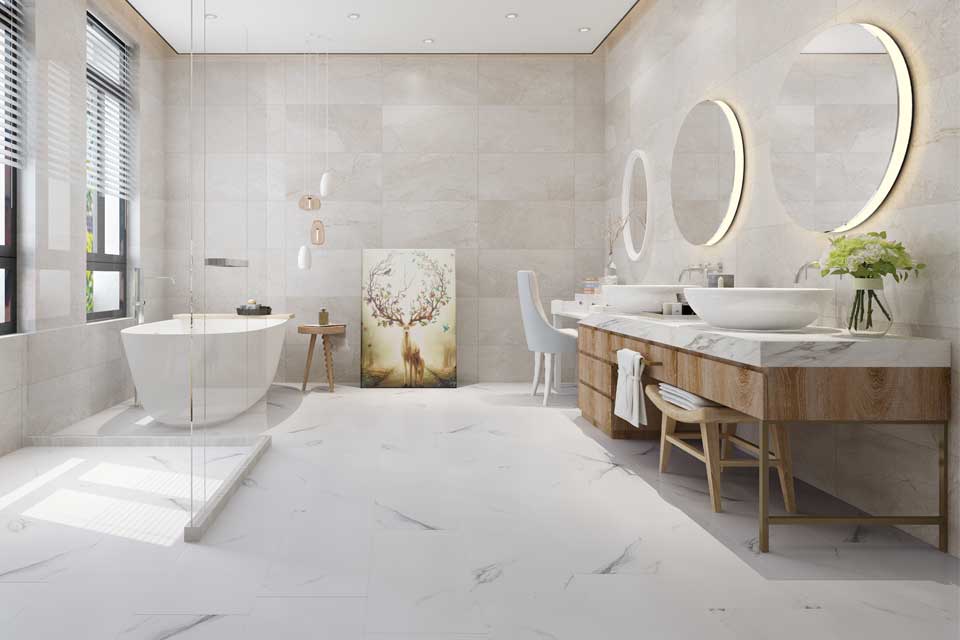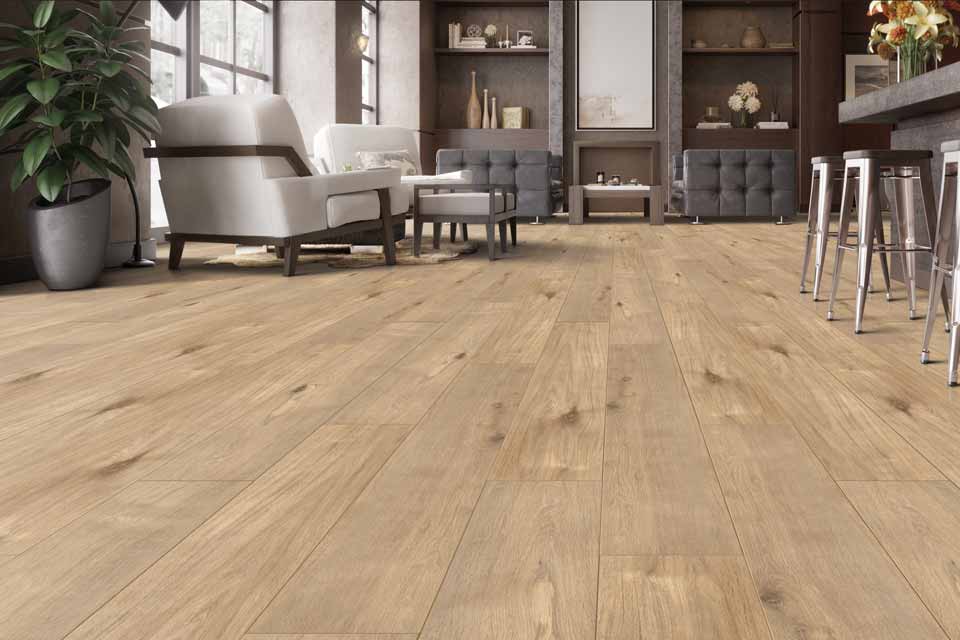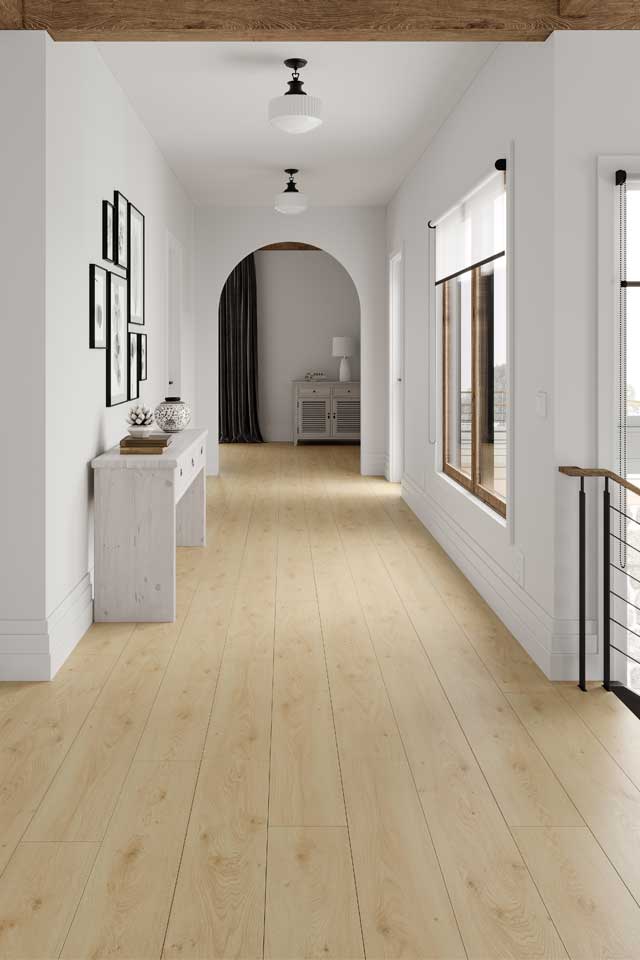

At Carpet One, we understand that choosing the perfect floor is a journey that blends dreams with practicality. Whether you're drawn to the warm allure of laminate or the resilient charm of vinyl, our commitment is to illuminate your path, making this crucial decision not just simpler but a memorable part of your home's story.
Laminate flooring, with its rich textures and diverse styles, invites you to embrace both the elegance and durability of modern living. Each laminate plank tells a story, echoing the beauty of natural wood or the sophistication of stone, all while offering an ease of maintenance that fits seamlessly into your life.
1. The Pros and Cons of Laminate Flooring
Laminate offers a harmonious balance of durability and design, bringing to life interiors as robust as beautiful. Yet, in rooms with excess moisture on the surface, laminate asks for caution, reminding us of the importance of water-resistant flooring.
2. Is Laminate Flooring Right for Your Space?
Laminate stands as a testament to versatility. Ideal for living areas and bedrooms, it's a choice that marries the look of luxury with practical living.
Vinyl flooring emerges as a resilient hero, ready to tackle life's spills and thrills gracefully. With many waterproof options, it can be an unfailing ally in bathrooms, kitchens, and beyond, offering a blend of style and functionality that ensures your home not only looks exceptional but stands up to busy living.
1. Advantages of Vinyl Flooring
With water-resistant capabilities and endless style options, vinyl flooring promises worry-free living spaces where beauty and practicality coexist.
2. Is Vinyl Flooring the Best Choice for Your Home?
For spaces where water is a constant guest and for homes bustling with activity, vinyl offers a durable embrace, ensuring your floors remain as inviting as the day they were installed.
In terms of durability, style, and cost, laminate and vinyl are more similar than you may think. Understanding their unique qualities ensures your choice not only reflects your style but meets your home's demands.
1. Durability and Longevity Both champions of durability, vinyl and laminate offer floors that withstand the tests of time and traffic, each with its own forte in the arena of home life.
2. Cost Considerations: Laminate vs. Vinyl Cost can be comparable for laminate and vinyl flooring. Our flooring experts will guide you to a choice that makes sense for both your aesthetic desires and financial considerations.
3. Installation and Maintenance Embracing simplicity, both flooring options offer ease of installation and care, ensuring your journey from selection to enjoyment is as seamless as the floors beneath your feet.
Choosing a floor that stands resilient is key. Discover which flooring option promises not just to endure but to thrive under the feet of your life's most precious moments.
1. Which is More Resilient for Busy Spaces? Weighing the resilience of laminate and vinyl, we uncover the secret strengths of each, guiding you to a decision that ensures your floors are not just seen but lived on.
2. Choosing the Right Flooring for Kitchens and Bathrooms In spaces where water is constant, the choice between laminate and vinyl remains comparable. Advancements in technology have led to the development of water-resistant laminate and vinyl. Discover water-resistant laminate options or water-resistant vinyl options.
The beauty of your floors extends beyond their installation. Maintain the allure of your laminate and vinyl flooring, ensuring they continue to reflect the beauty of your home with every step taken upon them.
1. Keeping Laminate Floors Looking Great Laminate requires gentle care; a simple sweeping and spot cleaning ensures its beauty endures through the years.
2. Tips for Caring for Vinyl Flooring Vinyl offers ease of care that welcomes water use, ensuring spills and stains are fleeting after a quick clean-up.

In the journey to select the perfect floor, making the right choice involves a blend of introspection and informed decision-making, a process we're here to support every step of the way.
1. Determining Your Budget and Aesthetic Preferences
Your journey begins with a reflection on what you envision for your home. What textures, colours, and styles speak to you? Do you yearn for the warm embrace of wood-like textures or the sleek sophistication of stone? These aesthetic preferences can guide you to a flooring that resonates with your personal style. Concurrently, an honest assessment of your budget grounds your choices in reality and opens the door to exploring a range of options that deliver on beauty without compromising financial comfort. At Carpet One, we pride ourselves on offering an array of flooring solutions that cater to diverse tastes and budgets, ensuring your dream floor is within reach.
2. Practical Considerations for Selecting the Ideal Flooring
Beyond the allure of aesthetics lies the realm of practical considerations. Here, the day-to-day life of your home takes center stage. How will the rooms be used? Are there areas prone to moisture or heavy foot traffic? Understanding the functionality of your spaces allows you to navigate towards flooring options that not only captivate visually but also stand up to the rigours of daily life. Whether it's the water-resistant virtues for a bustling kitchen or the durable elegance for a serene bedroom, we help you weigh these practicalities against your aspirations.

Embarking on the journey to select the right flooring is an adventure filled with questions, discoveries, and choices. At Carpet One, we're dedicated to helping you navigate this path, offering guidance that illuminates your way and ensures the foundation of your home reflects the beauty of your life. Whether you lean towards the rustic charm of laminate or the resilient allure of vinyl, we promise an enjoyable shopping experience.
By understanding the unique attributes and benefits of laminate and vinyl flooring, we empower you to make a choice that resonates with your home's needs and your personal style. Order your samples today or reach out for a free estimate.

1. What are the main differences between laminate and vinyl flooring?
Laminate and vinyl flooring stand as two pillars of modern flooring solutions, each with its distinctive characteristics. Laminate flooring is celebrated for its ability to authentically mimic hardwood's appearance through detailed imaging and texturing processes built on a strong core. Vinyl flooring, on the other hand, is a versatile option crafted from synthetic materials, offering unparalleled water resistance and durability. Vinyl comes in various forms, including luxury vinyl planks (LVP) and tiles (LVT), delivering a realistic look of hardwood, stone, or ceramic tiles.
2. Which is more durable, laminate or vinyl flooring?
When it comes to durability, both laminate and vinyl flooring offer robust options for modern homes. However, vinyl flooring often takes the lead in environments prone to moisture or heavy foot traffic, thanks to its water-resistant and sometimes fully waterproof nature. Laminate flooring, while durable and scratch-resistant, is better suited for areas with less exposure to moisture. However, recent advancements in technology have also made some laminates water-resistant.
3. How do installation costs compare between the two flooring types?
The installation costs for laminate and vinyl flooring are relatively comparable, making them both attractive options for budget-conscious homeowners. However, factors such as the subfloor condition, area size, and specific product choices can influence the overall cost.
4. Is laminate or vinyl better for high-traffic areas?
For high-traffic areas, vinyl flooring has historically emerged as the superior choice due to its exceptional durability and resistance to wear and tear. However, advancements in technology have made both vinyl and laminate flooring ideal for entryways, kitchens, and family rooms.
5. What are the maintenance requirements for each flooring type?
Both laminate and vinyl flooring boast low-maintenance qualities, making them suitable for busy households. Laminate flooring requires regular sweeping and mopping to maintain its appearance, with immediate clean-up of spills to prevent water damage. Vinyl flooring allows for more extensive cleaning methods, including wet mopping, making it an easy-care option for any room.
6. How can I determine which is the right choice for my home?
Choosing between laminate and vinyl flooring involves considering your home's specific needs, lifestyle, and aesthetic preferences.
Thank you for contacting Carpet One Floor & Home. Your local flooring expert will reach out to you regarding your inquiry.